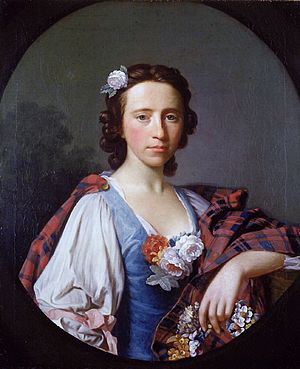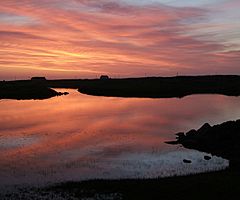Flora MacDonald facts for kids
Quick facts for kids
Flora Macdonald
|
|
|---|---|

Flora Macdonald by Allan Ramsay c. 1749–1750; the roses are a Jacobite symbol. Ashmolean Museum, Oxford.
|
|
| Born | 1722 Milton, South Uist, Scotland
|
| Died | 5 March 1790 (aged 67–68) Kingsburgh, Isle of Skye
|
| Nationality | Scottish |
| Known for | assisting Charles Edward Stuart after his defeat at the Battle of Culloden |
| Signature | |
Flora MacDonald (in Gaelic: Fionnghal nic Dhòmhnaill), born in 1722 and died on March 5, 1790, was a brave Scottish woman. She is famous for helping Charles Edward Stuart, also known as Bonnie Prince Charlie, escape from government soldiers. This happened after his army lost the Battle of Culloden in April 1746.
Flora's family usually supported the government. But she later said she helped Prince Charles because she felt sorry for him. She was arrested and held in the Tower of London. However, she was released in June 1747 as part of a general pardon.
Later, she married Allan MacDonald. In 1773, they moved to North Carolina in America. During the American Revolutionary War, they supported the British government. Because of this, they lost their land in America. They returned to Scotland, where Flora passed away in 1790.
Contents
Early Life

Flora MacDonald was born in 1722 in a place called Milton. This was on the island of South Uist in the Outer Hebrides, Scotland. She was the third and last child of Ranald MacDonald and his second wife, Marion. Her father was a landlord who managed land for the Clan MacDonald of Clanranald.
Flora's family was part of the Protestant group on South Uist, even though some MacDonald clans were Catholic. Her father died soon after she was born. In 1728, her mother married Hugh MacDonald, a landlord from the Isle of Skye. Flora was then raised by her father's cousin, Sir Alexander MacDonald, who was the leader of the Clan Macdonald of Sleat.
Helping Prince Charles Escape
Flora MacDonald was visiting Benbecula in the Outer Hebrides in June 1746. This was when Prince Charles and a few helpers were hiding there. They were on the run after losing the Battle of Culloden. One of Charles's friends, Captain Conn O'Neill, was a distant relative of Flora. He asked her for help.
Flora's step-father, Hugh MacDonald, was in charge of the government soldiers in Benbecula. This connection helped Flora get special passes. These passes allowed her to travel to the mainland. She seemed unsure at first, worried about what would happen to her family if they were caught. Some people later said that her step-father might have even secretly told the Prince where to hide.
The passes allowed Flora, six boatmen, and two servants to travel. Prince Charles dressed up as an Irish maid named Betty Burke. On June 27, they landed near Sir Alexander's house on Isle of Skye. Sir Alexander was away, but his wife, Lady Margaret, arranged for Charles to stay with her steward, MacDonald of Kingsburgh. Kingsburgh told Charles to take off his disguise, as it made him stand out more. The next day, Charles left Portree for the island of Raasay. Flora stayed on Skye, and they never met again.
Two weeks later, the boatmen were caught and told what happened. Flora and Kingsburgh were arrested and taken to the Tower of London. Lady Margaret spoke to a Scottish legal officer, Duncan Forbes, to help Flora. Flora was allowed to live outside the Tower under supervision. She was set free in June 1747 because of a special law that pardoned many people. Supporters collected over £1,500 for her. Even Frederick, Prince of Wales, who was next in line to the throne, contributed. Flora reportedly told him she helped Charles out of kindness, and would have done the same for him.
On November 6, 1750, when she was 28, Flora married Allan MacDonald. He was a captain in the British Army and Kingsburgh's oldest son. They first lived at Flodigarry on Skye. In 1772, they inherited the family estate after Kingsburgh died. The famous writer Samuel Johnson met Flora in 1773. He described her as "a woman of soft features, gentle manners, kind soul and elegant presence." He also wrote the words on her memorial at Kilmuir. It says her name will be remembered in history with honor for her courage and loyalty.
Moving to North Carolina
During the Seven Years' War (1756–1763), Allan MacDonald served as a soldier. But he was not good at business. After arguments with his landlord over money, he and Flora moved to Anson County, North Carolina in 1774. They started a farm they called 'Killegray'.
When the American Revolutionary War began in 1775, Allan gathered about 1,000 men. These men were called Loyalists because they supported the British government. Their sons, Alexander and James, also joined.
It is said that on February 15, 1776, Flora spoke to the soldiers in their Gaelic tongue. She encouraged them with great passion. This kind of speech was known as a "brosnachadh-catha" or "incitement to battle" among Scottish clans. The soldiers then marched to the coast to meet British reinforcements. But they were ambushed at Moore's Creek Bridge on February 17. Allan MacDonald and his troops were captured.
After the battle, Flora was questioned by a local committee. She showed "spirited behaviour" during this time. In April 1777, all property owned by Loyalists was taken by the government. Flora was forced to leave Killegray and lost everything she owned.
Allan was held captive for 18 months. He was released in September 1777 as part of a prisoner exchange. He was then sent to Fort Edward, Nova Scotia, to lead the 84th Regiment of Foot. Flora joined him there in August 1778.
Return to Skye
After a very cold winter in Halifax, Nova Scotia, Flora sailed for London in September 1779. She was on a British ship called the Dunmore. During the trip, she broke her arm. Her poor health delayed her return to Scotland until spring 1780.
For the next few years, she lived with different family members. This included staying at Dunvegan, the home of her son-in-law, Major General Alexander MacLeod. He was the biggest landowner on Skye after the MacDonalds. The money they received for their lost property in North Carolina was not enough to settle in Nova Scotia. So, Allan returned to Scotland in 1784. Kingsburgh, their family home, was now occupied by Flora's half-sister. Allan started farming nearby in Penduin instead.
A historian named J.P. MacLean said that Flora often mentioned serving both the House of Stuart (Prince Charles's family) and the House of Hanover (the British royal family). She felt she had faced difficulties supporting both.
Flora died in 1790 at the age of 68. She was buried in Kilmuir Cemetery. Her husband followed her in September 1792. They had seven children who survived: two daughters and five sons. Two of their sons were lost at sea. A third son, John, became very wealthy in India. This allowed his parents to live comfortably in their final years.
Legacy

Stories about Prince Charles's escape often focus on him. Flora is sometimes seen as less important, not getting enough credit. She rarely talked about helping him. Her last meeting with Charles was when they said goodbye at Portree. It seems one reason she helped him was to protect her family from danger.
During the Victorian era, people created a strong Scottish identity. This included things like tartans, Burns Suppers, and Highland Games. They also celebrated romantic figures like Mary, Queen of Scots and Bonnie Prince Charlie. In 1878, Flora MacDonald became one of these heroes. An "Autobiography" was published, supposedly by her. But it was actually written by her granddaughter, Flora Frances Wylde. It had many mistakes, so Flora herself could not have written it. Many of these errors were repeated in a book by Charles Ewald in 1886. This book is still the basis for many popular ideas about Flora's life.
In 1884, Sir Harold Boulton wrote new words for an old tune. He called it 'The Skye Boat Song'. Soon after, the Scottish dance "Flora MacDonald's Fancy" was performed for the first time. A bronze statue of Flora was put up at Inverness Castle in 1896, with her dog Flossie beside her.
The Flora MacDonald Academy in Red Springs, North Carolina is named after her. Two of her children are buried on its campus. Until 2009, it was also the location of the Flora Macdonald Highland Games.
Flora MacDonald was painted several times by the Scottish artist Allan Ramsay. Most of these paintings still exist today. The one used in this article was painted after she was released from the Tower in 1749–1750. In 2015, another painting, also thought to be by Ramsay, was found in Florida.
In Popular Culture
- In the 1948 film Bonnie Prince Charlie, Flora MacDonald is played by Margaret Leighton. David Niven plays Prince Charles. Niven later said the film was "one of those huge, showy movies that seem doomed from the start."
- Inglis Fletcher wrote The Scotswoman (1954). This novel is based on Flora MacDonald's life in North Carolina during the American War of Independence.
- In the TV show Highlander: The Series, an episode called "Take Back the Night" features an Immortal named Ceirdwyn. She lives as "Flora MacDonald" when Charles and his group stop by, looking for a boat to France.
- The 2005 novel A Breath of Snow and Ashes is the sixth book in Diana Gabaldon's Outlander series. It includes a story about Flora MacDonald arriving in the Colony of North Carolina. She was played by Shauna Macdonald in Season 6, Episode 5, "Give Me Liberty."
Error: no page names specified (help). In Spanish: Flora MacDonald para niños
In Spanish: Flora MacDonald para niños



